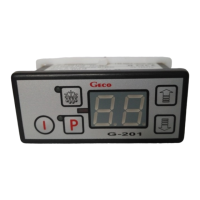Page 5
V. INSTALLATION OF SENSORS.
1. For every type of the cooling unit the place of fixing of chamber and evaporator sensor and setting
of system parameters G-201 should be chosen through experimentation. It is absolutely forbidden
to change the location or the method of fixing of sensors and settings of G-201 without doing new
tests related to temperature stabilisation and to the course of defrosting of the unit!!!
2. The chamber sensor must be fixed in such a way that it does not touch foods and is not exposed to
damage during cleaning of the unit. A special plastic handle can be used to fix this sensor. Such
solution causes quick (time delay on/off see V, item 4) the reaction of the sensor and of the whole
thermostat to a change of air temperature in the unit. If it is recommended or necessary to slow
down and ‘smooth out’ reaction time of the sensor to temperature changes, it is advisable to screw it
to a metal element of the unit.
3. Evaporator sensor should be fixed in the way which assures maximally good and sure contact with
the evaporator slat and in the place where ice keeps longest during defrosting. Its fixing should
prevent its pushing out by growing ice. If possible, sensors should be fixed vertically so that the
cable goes out of a sensor at its bottom.
4. Sensor cables can be shortened or lengthened in any way according to the following rules:
- Cable sensor should not be cut at a distance below 0.5 m from the shell
- It is not recommended to lengthen sensor cable above 20 m.
- SENSOR CABLES CAN BE CONNECTED TO SENSOR CLAMPS IN THE OPERATING
UNIT IN ANY WAY!!!
(similarly to the method of plugging of the plug in the socket ~230V)
- cable OMY 2x0.5 mm is recommended for cable lengthening,
- if cables are lengthened their connection should be done very carefully, every pair of veins
should be soldered and heat-shrinking sheaths should be put on them. Then the place of
connection should be filled with water-resistant silicone and one more heat-shrinking sheath
should be put on..
- endings of cable connected to the independent control unit should be tinned.

